Wednesday, August 28, 2019
Sunday, August 25, 2019
Long Run
This week was a longer/harder one for running, and as usual today (Sunday) was my long run of the week. I wasn't sure how far I was going to go - at least the 18km loop around the bridges, but maybe 21 or 25 depending on how I felt. Two weeks ago I'd done 25 and been fairly wiped out by the end, so logically I wouldn't go any farther till I could do that more comfortably.
I wasn't feeling that lively when I got up. I would have waited to wake up more, but I had to be back for lunch so I started at 8am. My legs felt a little heavy, as if I hadn't quite recovered from my harder Tues and Thurs runs. But my pace and heart rate were decent. (I wear a chest strap to get an accurate heart rate.)
Usually when I get past 15 or 20 km my heart rate starts to rise even if I keep my pace constant. But despite feeling a bit tired, my heart rate stayed level, so I figured I should go longer, maybe 25 km. At 20 km my heart rate was still recovering to below 100 after a minute of walking (I was doing 9 min run, 1 min walk) so I started to think about 30 km, which hadn't even crossed my mind until then. That meant another hour of running, but I was in the groove and that didn't sound so bad.
After about 25 km my heart rate started to creep up despite dropping my pace a little. But I knew I could sustain a higher heart rate for the last 5 km. I was ahead of my target pace so slowing down slightly was ok. And I was feeling good enough to kick a little on the last couple of kilometers.
I could feel my left foot start to get a bit sore but it didn't seem too bad. It felt worse two weeks ago and still recovered quickly. My right foot had a hot spot but it seemed like I could finish before it developed into a blister. Otherwise I felt good.
The last few kilometers I quit worrying about keeping my heart rate under control and sped up to a pace I figured I could sustain till the end. I finished the 30 km a couple of minutes under my goal, which I was pretty happy about. I'd almost given up on longer than about 20 km due to the foot problems, but it seems to have improved or toughened up a bit. Maybe 35 km is doable? And if 35 km, then maybe 42? We'll see. Hopefully I'll be smart enough not to push too far too fast and end up with a setback. In any case, I'll go short/easy this coming week and let my body recover.
I wasn't feeling that lively when I got up. I would have waited to wake up more, but I had to be back for lunch so I started at 8am. My legs felt a little heavy, as if I hadn't quite recovered from my harder Tues and Thurs runs. But my pace and heart rate were decent. (I wear a chest strap to get an accurate heart rate.)
Usually when I get past 15 or 20 km my heart rate starts to rise even if I keep my pace constant. But despite feeling a bit tired, my heart rate stayed level, so I figured I should go longer, maybe 25 km. At 20 km my heart rate was still recovering to below 100 after a minute of walking (I was doing 9 min run, 1 min walk) so I started to think about 30 km, which hadn't even crossed my mind until then. That meant another hour of running, but I was in the groove and that didn't sound so bad.
After about 25 km my heart rate started to creep up despite dropping my pace a little. But I knew I could sustain a higher heart rate for the last 5 km. I was ahead of my target pace so slowing down slightly was ok. And I was feeling good enough to kick a little on the last couple of kilometers.
I could feel my left foot start to get a bit sore but it didn't seem too bad. It felt worse two weeks ago and still recovered quickly. My right foot had a hot spot but it seemed like I could finish before it developed into a blister. Otherwise I felt good.
The last few kilometers I quit worrying about keeping my heart rate under control and sped up to a pace I figured I could sustain till the end. I finished the 30 km a couple of minutes under my goal, which I was pretty happy about. I'd almost given up on longer than about 20 km due to the foot problems, but it seems to have improved or toughened up a bit. Maybe 35 km is doable? And if 35 km, then maybe 42? We'll see. Hopefully I'll be smart enough not to push too far too fast and end up with a setback. In any case, I'll go short/easy this coming week and let my body recover.
Saturday, August 24, 2019
Prints of the Week
For me, the real test of my photographs is whether I can make a big print that I'm happy with. I know the rest of the world is content to look at tiny images on their phone, but that's not for me. It strikes me as odd that everyone has to have a six foot tv, but they're happy to look at photographs on a two inch phone. A reflection of how being inundated with photographs has devalued them.
The first print was a yellowjacket wasp that landed on the chair where I was sitting having lunch by the pond at Innovation Place. When they are collecting wood pulp for their nests they stay in one place long enough to photograph. And I happened to have my new camera handy even with the macro lens already on. The wasp was moving a bit too much for focus stacking, but the camera did quite well at focusing where I wanted. I love being able to get a sharp enough image of something this small to print 17" x 22".
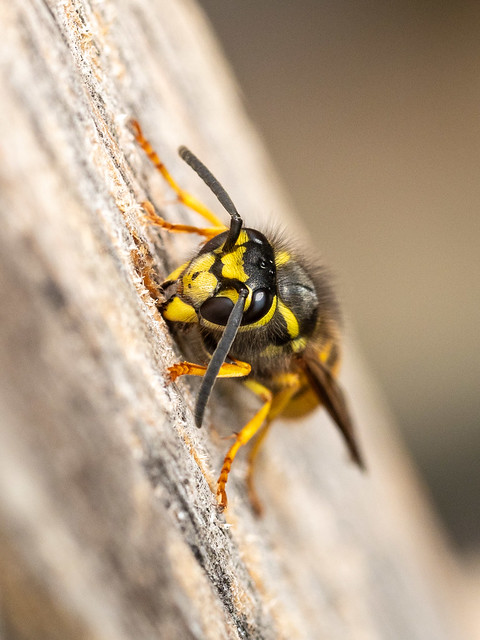
The pond area of Innovation Place seems to get busier and busier, presumably as more people find out about it. It is lovely, but it's not very big, so it doesn't take too many people to get a little busy for my liking. Thankfully when I arrive in the morning for work, it's still quiet and I can wander and take photographs without the nuisance of other people.
My second print was just the pond itself and the reflections. Why don't we have more green places like this? To think we could have moved our offices to the industrial area.

The first print was a yellowjacket wasp that landed on the chair where I was sitting having lunch by the pond at Innovation Place. When they are collecting wood pulp for their nests they stay in one place long enough to photograph. And I happened to have my new camera handy even with the macro lens already on. The wasp was moving a bit too much for focus stacking, but the camera did quite well at focusing where I wanted. I love being able to get a sharp enough image of something this small to print 17" x 22".

The pond area of Innovation Place seems to get busier and busier, presumably as more people find out about it. It is lovely, but it's not very big, so it doesn't take too many people to get a little busy for my liking. Thankfully when I arrive in the morning for work, it's still quiet and I can wander and take photographs without the nuisance of other people.
My second print was just the pond itself and the reflections. Why don't we have more green places like this? To think we could have moved our offices to the industrial area.

Sunday, August 18, 2019
New Camera

I recently bought a camera I'd been looking at for a while - an Olympus OM-D E-M1 Mark II. It was actually released several years ago, but the new version they released, the E-M1X, is quite a bit bigger and quite a bit more expensive so I wasn't interested.
I've been happy with my Nikon 7200. They also released a new version, the 7500, but it didn't really have any big new features.
The main attraction with the Olympus is that it's a "micro four-thirds" sensor. The 7200 has an APS-C sensor with a 1.5 crop factor. Micro four-thirds has a crop factor of 2, i.e. a smaller sensor. Technically bigger sensors are better. But the bigger the sensor, the bigger the camera and the lenses, especially long telephoto lenses. The sensor is 20 mega pixels versus 24 for the 7200, but that's still plenty for me, and probably better for a smaller sensor to have less pixels.
I'm usually either traveling or hiking (or both) so size and weight are important. I'm hoping with the Olympus that I'll be more likely to carry it (and lenses).
Here's a comparison with my macro lenses. The Olympus macro lens is actually brighter (f2.8 vs f3.5) which usually makes it bigger, but it's tiny. (And I'm really happy with the results from it.)

It's a "mirrorless" camera, as opposed to a DSLR like the 7200. So it has an electronic rather than optical viewfinder. There are pros and cons to both. Optical viewfinders are nice, they're bright and instant. Electronic viewfinders have less resolution and can lag slightly. But electronic viewfinders can do a lot more - they can display other information, they can highlight what's in focus or what's too dark or too light, and they can show you what the final image will look like. And in low light, they can be brighter than an optical viewfinder.
Despite it's small size, the EM1 has a large number of physical dials and buttons (as well as a touch screen). And you can customize almost all of them from the huge menu system. Depending on your preferences, this might be a good feature or a bad one. Personally I like having lots of physical controls and being able to configure them for the things I use. (and I'm not intimidated by the complex menus)
The screen is also articulated. I don't need that a lot, but when I do (e.g. shooting an insect in an awkward position) it's very handy. It also means you can fold it screen face in so it's protected, which is nice when the camera may get bumped around.

Another big selling feature is the image stabilization built into the camera body. My old Pentax DSLR's had that and I loved it. Whereas most Nikon and Canon DSLR's depend on the lenses to provide image stabilization. The Olympus is known for having the best image stabilization (they claim 5.5 stops difference). I seldom use a tripod and hand hold almost all of my shots, so good stabilization is crucial to getting sharp results.
In the past, autofocus on mirrorless cameras didn't work as well as DSLR's. But it has improved a lot, and I've been impressed with how fast and well it works on the EM1.
It doesn't have a built in flash, but it does come with a tiny external flash that is powered by the camera.
One of the features I was look forward to was "focus bracketing", where the camera captures a series of images with slightly different focus. Afterwards, on the computer, you can either choose the one with the best focus, or you can combine multiple shots into one (focus stacking). This is especially valuable for macro photography where the depth of focus is extremely shallow. I've done a bit of this in the past where I've happened to get shots with different focus that I could combine. But unless you use a tripod and focusing rail it's very hard to do focus bracketing manually. With the new camera it shoots the series of shots rapidly, which is important because you don't want the subject (e.g. an insect) to move during the sequence. (If you look closely at the first image you can see that the fly moved its leg between shots. You could fix the focus stacking, but I haven't got that fancy yet.)

It likely won't excite anyone but me, but I love the detail in this focus stacked moth.

My one complaint about the focus bracketing is that it isn't bracketing. Normally "bracketing" means taking shots either side of what you think is right. The focus bracketing doesn't do that, it just goes back (further away) from where it starts. That means you have to start by focusing on the closest point of the subject. But with an insect or even a flower, it's not always easy to pick out the closest point. It would be nice if you could configure it to take some shots with a closer focus as well as farther. Maybe they'll add that in a firmware update (they have a history of adding features via software update).
[Update: six months later I discovered it does have this feature, in a round about way. If you turn on Focus Stacking so that it combines the shots in camera, then it does bracket either side of your focus point. I normally prefer to do the stacking on my computer with Photoshop so I hadn't paid attention to this feature. But it saves the original shots as well as the stacked version, so I can still stack in Photoshop if I want. It still seems odd that this feature isn't a little more direct, but at least it's there.]
If you look closely at this focus stacked image, you'll see that parts of the petals are slightly out of focus. That's because I missed the closest point.

Even without focus stacking the camera and macro lens do a great job. This fly was tiny - about 1/4".
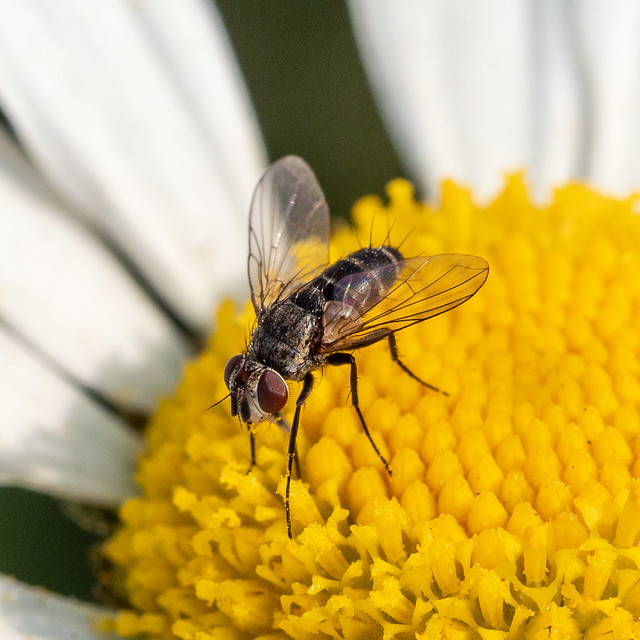
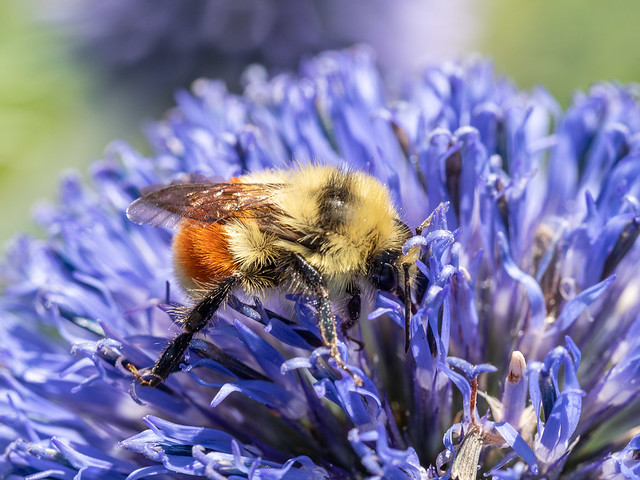
A few more random shots as I test the new camera and lenses.

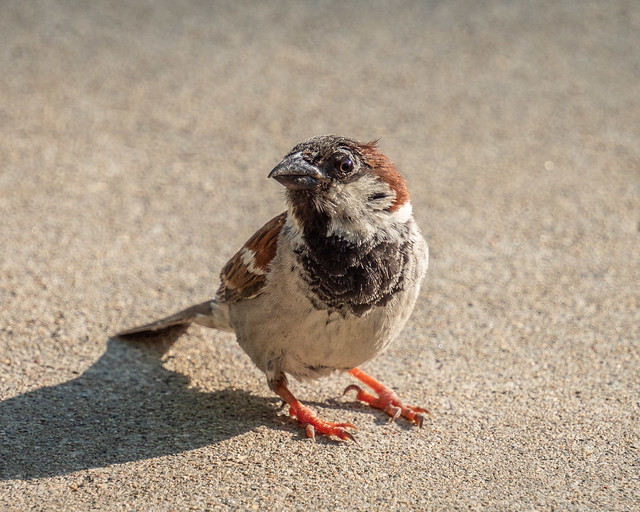

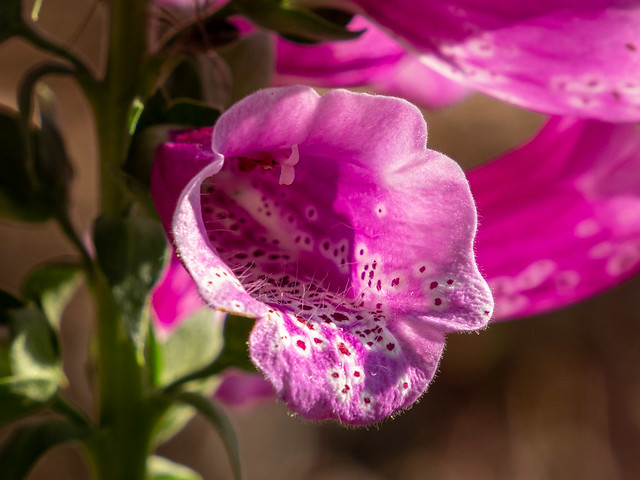

The selection of lenses for micro four-thirds is decent, but not as good as for Nikon or Canon. My "normal" lens on my Nikon is 27 to 600mm equivalent. That's a huge range, from moderately wide to quite long. The closest equivalent for the Olympus is 24 to 400 equivalent. That a good range, but definitely not as long. My "big" lens for the Nikon is 225 to 900 equivalent. The "big" lens for the Olympus is 600mm equivalent, with a teleconverter taking it to 900 mm, but no zoom. For now, I settled for a smaller, lighter (and cheaper) 150 to 600 mm equivalent. I haven't used it much yet, but here are a couple of sample shots.


So far I'm really happy with the new camera. I've got some shots I'm really happy with that I don't think I could have got with my Nikon.
See all 55 photos in this album
Subscribe to:
Posts (Atom)

